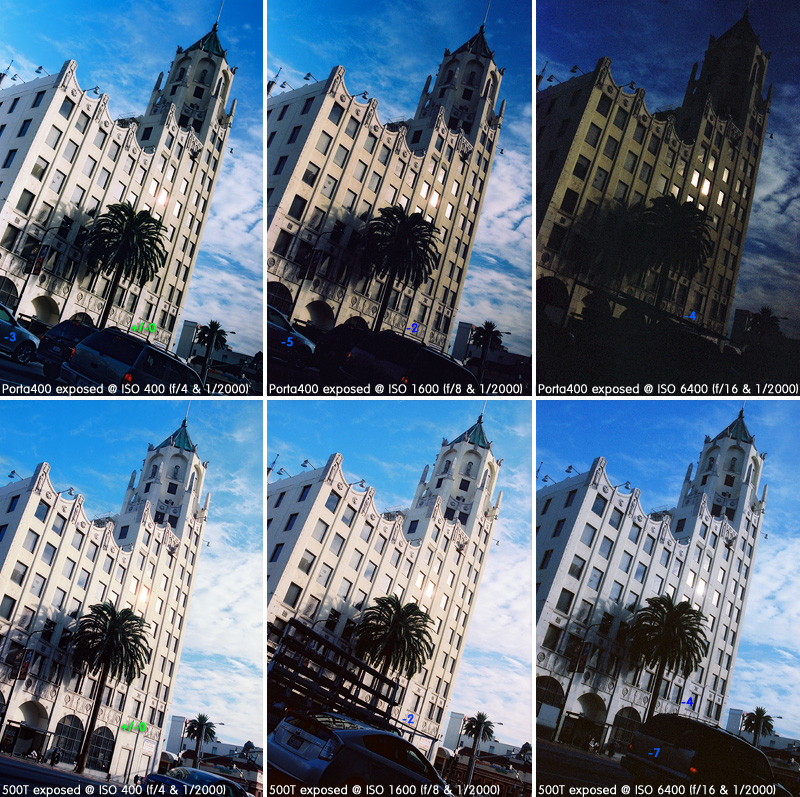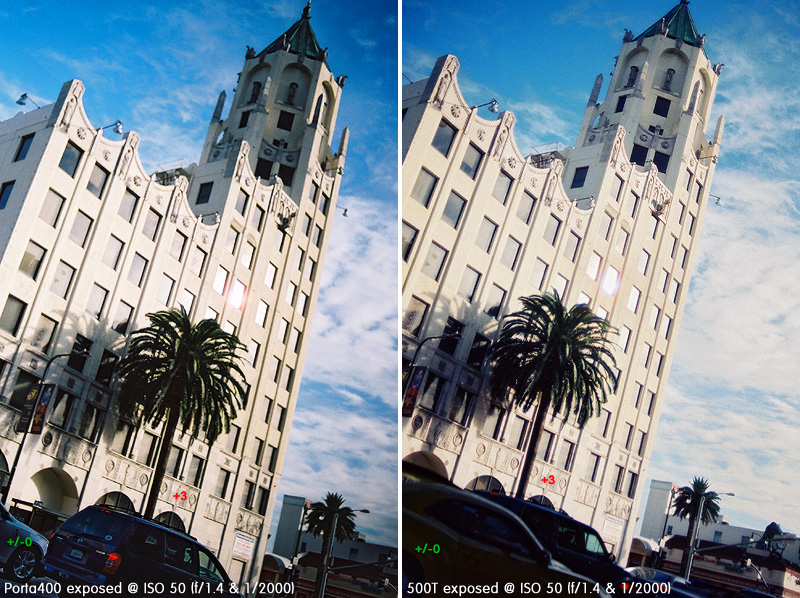As we find ourselves nearing the darkest night of the year, more and more we end up losing light right when the most memorable moments are flashing before us. We do stretch the light we have as far as it can go, with fast lenses and high speed B&W film, but this season we have been capturing life as a movie with Kodak's Vision3 motion picture film. We will usually push the 500T at least 1 stop, and rate it regularly at ISO 1600, to capture all the colorful subtlety of what we witness in the faint fading light. This stuff works wonders! All year long we have been enjoying the light that cinematographers have been spoiled with for years, but now the Vision Technology has been passed down to all still photographers through the new Portra 400.
When Kodak sent us some "sample" Portra 400 in 35mm to test, we immediately had to see how it compared to our beloved 500T. Of course Portra is not Tungsten balanced, but we decided to rate them both the same, unfiltered, without push processing at all, and see how closely they are related. Since we have had good experiences rating the 500T from ISO 400-1600 with great latitude, we chose to stretch it a stop in either direction at night with mixed, contrasty, lighting. All the scanning was done on the Frontier with, surprisingly, very little color correction to match the stocks.

We didn't know what to expect, but it appears that they are very similar emulsions, with almost identical grain structure (due to the Vision hand-me-down). It seems that the 500T has a little less contrast, and picks up a bit more detail in the mixture of lighting. But both seem ideal for push processing to bump up the soft detail in the underexposed areas.
Shooting in extreme bright and shadowed scenes was the other strong suit that we had discovered of the 500T & 250D, so we found a high contrast evening location of a white building with glaring sun and deep shadows. We metered for the diffused light hitting the base of the building, then shot every aperture from f/1.2 all the way down to f/16 at 1/2000 sec.! To spare you the redundancy of looking at the same shot 16 times we selected the shots where the exposure actually made a difference.


It seems that both stocks do very well rated to be between 3 stops over (50), and 2 under (1600) in the mid-tones, which allows for a 6 stop margin of error. But the 500T still holds some exposure as much as 7 stops under! I would not knowingly underexpose even these amazing films more than a stop without push processing, though I also would shoot with confidence that no matter where I meter a scene the image will expose well. I mean, thats why we shoot film essentially. We don't need to chimp a shot, or even re-meter much at all, especially knowing that if we err on the side of overexposure it will be beautiful. And apparently the occasional underexposed shot would turn out as well! Granted, one would have to try very hard to underexpose an image 4 stops, especially when you know you could go over 8 stops in the highlights and be golden. It's the difference of f/1.4 and 16 for goodness sakes! What I walk away with from this example is; that no matter what the lighting situation is, or how you are reading the light, all the precious times and moments in life can be (as it should be) lived like a movie. :-)
Happy holidays from The Wright Brothers!







9 comments:
Been holding out on us with the 35mm, huh?
I can't quite get my head around why the Portra seems to track the 500T pretty well in the night shot (more contrast, but a similar loss of shadow detail each step), and is WAY off with the daylight scene. Is it because the night shot is a more contrasty scene, and so the highlights take advantage of the overexposure latitude?
The "+1" in the night scene: did you spot-meter from there?
Now to see how it pushes! Gonna show us that next? I'm wondering how the grain holds up if you push it.
Yes that is spot metered. In the night shot, the spot that was metered was near the darkest tone in the scene, and was tested up to 3 stops underexposed. Which let's the darkest detail (not counting the black sky) only fall a few stops under that, within range of both stocks. In the daylight scene, the sunlight was metered off of a light subject. Thus the shadows started a good 3 stops under. Once we underexposed our subject 4 stops this time, the shadowed street finally fell beyond the latitude of the films. Plus, in the night shot, your eye expects black portions, cuz it's what you'd see. Basically, in order to fail to collect any detail (cuz detail can't really be lost, just missed, on negs) with these films you'd need to underexpose the highlights of your image. Very comforting to any photographer nervous about the risk of film exposures not turning out! :-)
I was shocked to find in my own testing that there was so little difference from -2 to +3. Simply amazing. Thank you for all the work you have done.
Where do you process your ecn-2 film?
Its not an easy task. Fotokem processes it. We have an account at Technicolor too, but they are moving their lab facility right now. We are fortunate enough to live in Hollywood. ;-)
IS there a minimum processing amount? how much do you pay per roll? now that seattle filworks is no more it's difficult to process. how do you remove the remjet safely at home?
approx. how much per roll are you paying technicolor? have you tried to home process and remove the remjet by yourself? if so, what works safely without scratches?thansk
Technicolor has a $50 minimum which we never meet. We've done 20-30 rolls for less than $50. We don't mess with the rem-jet anymore. Just let the lab do it. Look up The Camera Shop in St. Cloud, MN. The still process single rolls SFW (C-41) style.
Love the new portra400.. need to shoot some 35, been to busy with the 120.
Thanks for posting this, I wasn't sure how well it would handle pish processing.. can't wait to try it out!
Post a Comment